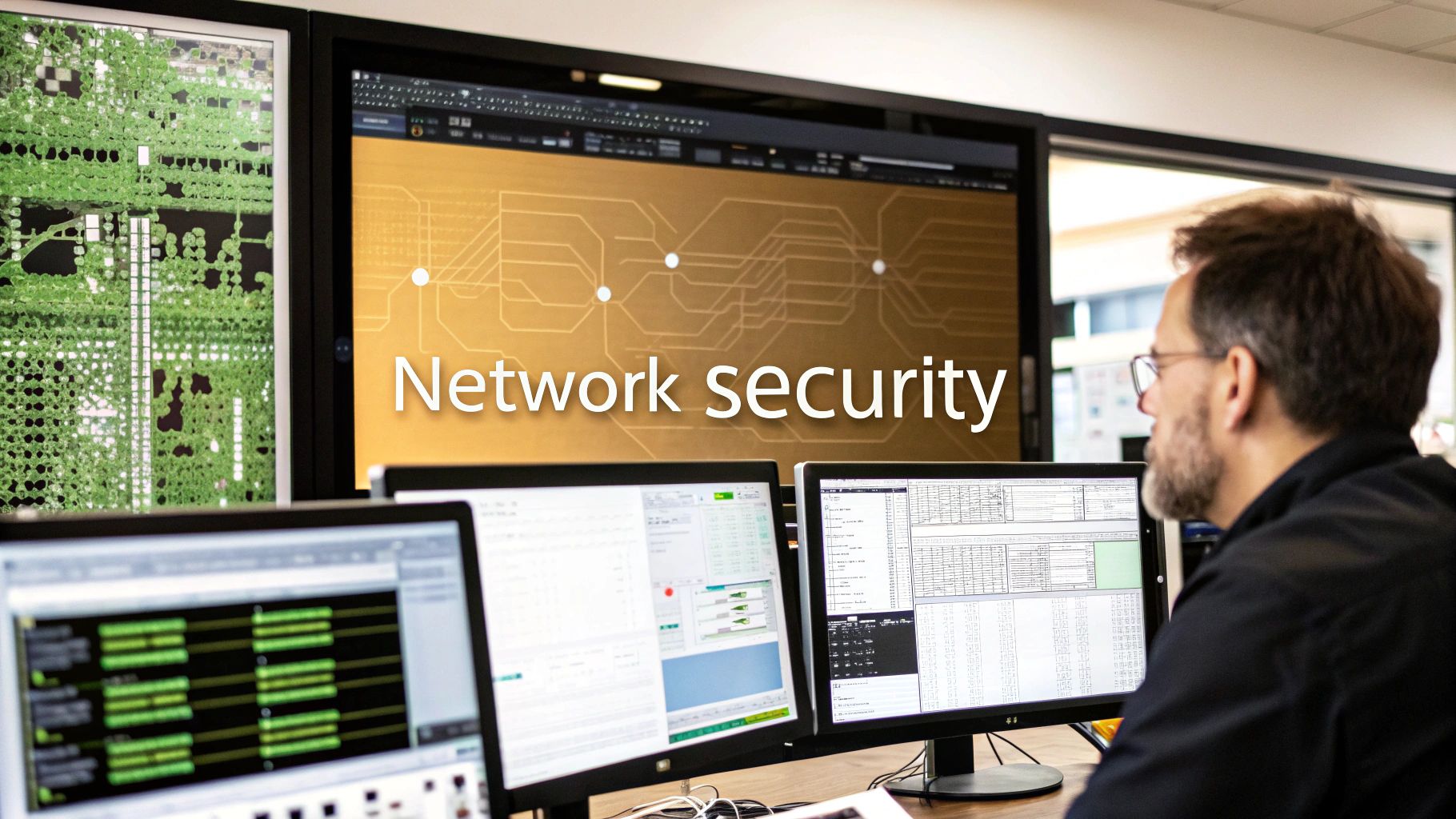Beyond the Firewall: A Deep Dive into Essential Network Security Monitoring Tools
A reactive security posture is no longer sufficient for modern businesses. Organizations, particularly those managing high-traffic networks in hospitality, multi-family housing, senior living, and commercial venues, face a constant barrage of sophisticated cyber threats. Protecting sensitive guest data and ensuring uninterrupted service requires proactive, 24/7 vigilance across the entire network infrastructure, from the core to the edge. This is where robust network security monitoring tools become indispensable, providing the visibility needed to detect and respond to threats in real time.
This guide moves beyond generic lists to provide an in-depth analysis of the top 12 network security monitoring solutions for 2025. We will dissect the core functionalities, uncover practical limitations, and detail specific implementation considerations for each platform. You will gain a clear understanding of how these tools operate in real-world scenarios, such as securing guest Wi-Fi in a hotel, protecting resident data in an apartment complex, or ensuring PCI compliance in a retail space. Our goal is to equip you with the detailed insights necessary to select the solution that best aligns with your unique operational needs, budget, and security requirements, ensuring your digital assets remain resilient.
1. Splunk Enterprise Security
Splunk Enterprise Security (ES) stands as a premium Security Information and Event Management (SIEM) solution, earning its place at the top of our list for its powerful data aggregation and analytics capabilities. It excels at converting vast streams of machine data from network devices, servers, and applications into actionable security intelligence. This makes it one of the most comprehensive network security monitoring tools available for organizations managing complex IT environments.

For a large hotel chain or a multi-family property group, Splunk ES can correlate Wi-Fi access logs with guest check-in data and point-of-sale transactions to detect anomalous behavior, such as unauthorized access to guest networks or fraudulent activity. Its machine learning algorithms can identify subtle patterns that indicate a brewing threat, which is crucial for preventing data breaches. To fully leverage its potential, it’s vital to understand the principles of effective network surveillance, so we recommend you explore these network monitoring best practices.
Key Features and Considerations
- Advanced Threat Detection: Utilizes machine learning to detect sophisticated threats that traditional signature-based tools might miss.
- Customizable Dashboards: Offers highly flexible dashboards, allowing IT managers to create views specific to their property’s needs, such as monitoring guest Wi-Fi security separately from corporate network activity.
- Implementation: Deployment is resource-intensive and requires significant planning. New users should expect a steep learning curve to master its proprietary Search Processing Language (SPL).
- Pricing: Splunk’s pricing is based on data ingestion volume, making it a significant investment best suited for larger organizations with dedicated security teams.
2. IBM QRadar
IBM QRadar is a powerful Security Information and Event Management (SIEM) solution renowned for its intelligent security analytics. It excels at collecting, correlating, and analyzing log and event data from thousands of endpoints, devices, and applications across a network. By applying advanced behavioral analytics, it provides real-time visibility into potential threats, making it one of the most effective network security monitoring tools for organizations aiming to reduce incident response times and minimize false positives.
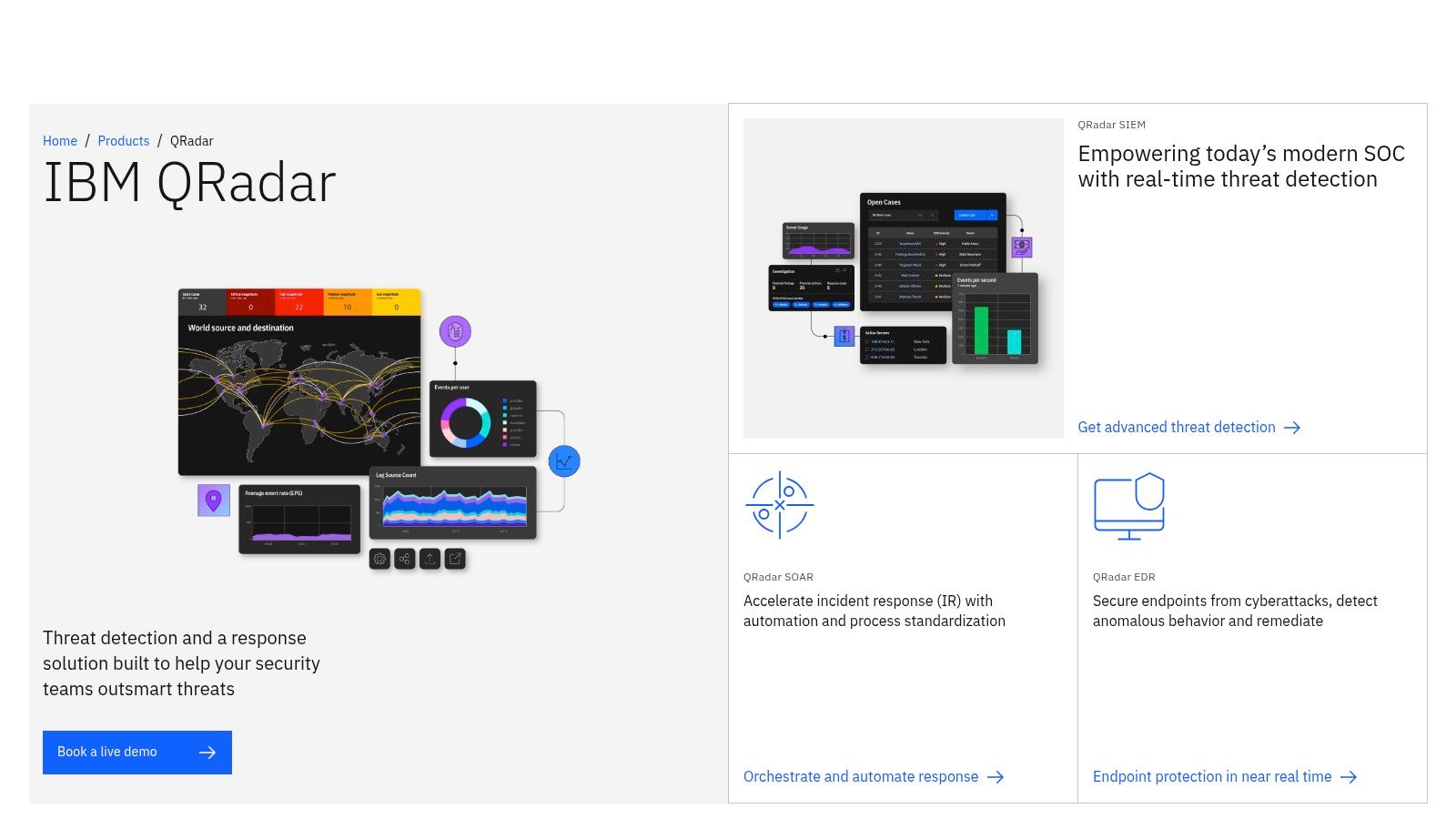
For a commercial venue like a shopping center or a large senior living facility, QRadar can monitor network traffic from public Wi-Fi, security cameras, and building management systems. Its user behavior analytics can quickly flag unusual activity, such as a device suddenly attempting to access sensitive administrative controls or an influx of malware signatures from a specific network segment. This capability helps security teams prioritize the most critical alerts, preventing minor issues from escalating into significant security breaches.
Key Features and Considerations
- Real-Time Correlation: Aggregates and correlates data from disparate sources to provide a unified view of security events as they happen.
- Behavioral Analysis: Uses User Behavior Analytics (UBA) to establish a baseline of normal activity and detect anomalies that may indicate an insider threat or compromised account.
- Implementation: The initial setup can be complex and often requires professional services or a dedicated IT team with specialized knowledge for proper configuration and tuning.
- Pricing: QRadar’s pricing is at a premium level, making it a better fit for large enterprises that can allocate significant resources for deployment and ongoing maintenance.
3. Palo Alto Networks Cortex XDR
Palo Alto Networks Cortex XDR is an extended detection and response platform that consolidates security data from endpoints, networks, and the cloud. It moves beyond traditional SIEMs by integrating prevention, detection, and response into a single, cohesive system. Its strength lies in using AI and behavioral analytics to stitch together disparate alerts into a clear narrative of an attack, making it an exceptional choice among network security monitoring tools for organizations needing a unified defense strategy.
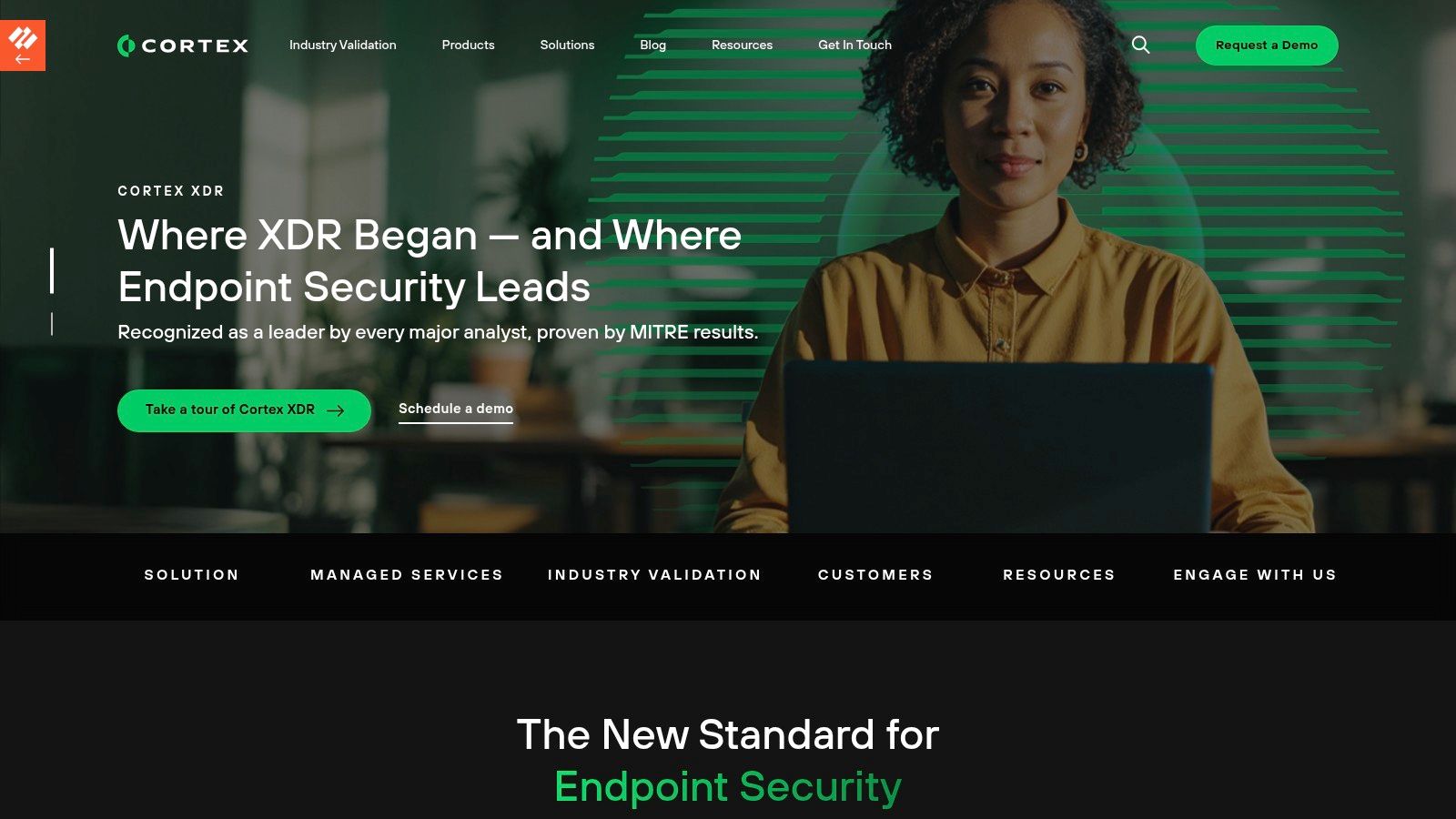
For a senior living facility, Cortex XDR can monitor the network for unusual traffic patterns originating from IoT medical devices or resident personal devices, quickly identifying a compromised device that could lead to a data breach. Its automated response capabilities can instantly isolate an affected endpoint from the network, preventing an incident from spreading across sensitive systems that manage resident health records. The platform’s high-fidelity alerts reduce the noise that often plagues IT teams, allowing them to focus on genuine threats.
Key Features and Considerations
- Unified Data Integration: Combines endpoint, network, and cloud data to provide comprehensive threat visibility without needing multiple tools.
- AI-Driven Analytics: Leverages machine learning to analyze behavior and detect stealthy attacks, significantly reducing false positives.
- Implementation: Best suited for organizations already invested in the Palo Alto Networks ecosystem. Achieving optimal performance requires specialized expertise for configuration and management.
- Cost: Cortex XDR is a premium solution with a higher price point, reflecting its advanced capabilities and unified platform approach.
4. Darktrace
Darktrace distinguishes itself by using self-learning AI to provide autonomous cyber defense. Instead of relying on predefined rules or signatures, its Enterprise Immune System learns the unique “pattern of life” for every user, device, and network segment it monitors. This approach allows it to detect subtle deviations from normal behavior that signify emerging threats, making it one of the most proactive network security monitoring tools for identifying novel and sophisticated attacks in real-time.
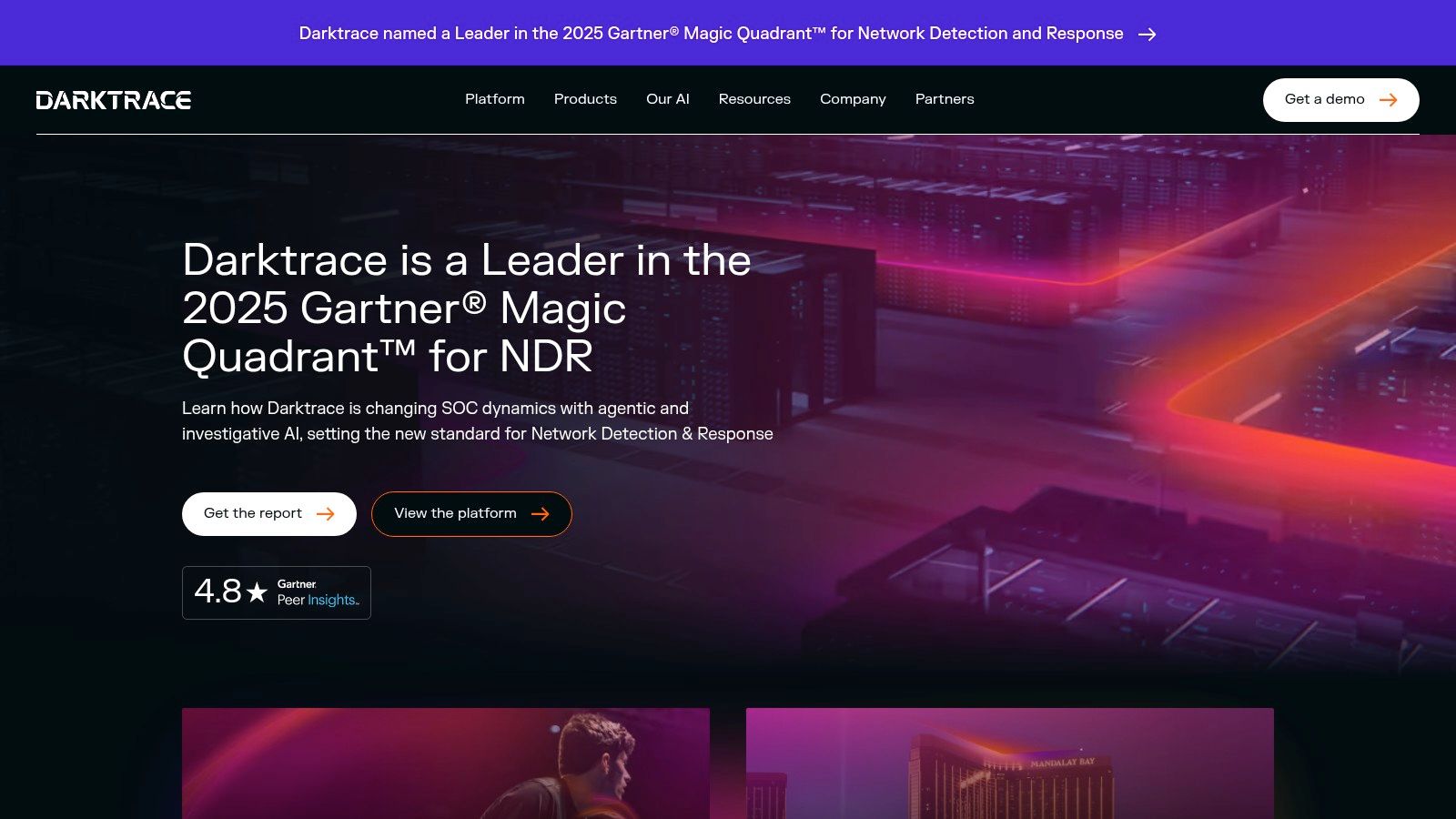
For a large resort or commercial venue with a constant flow of new guest devices connecting to its Wi-Fi, Darktrace can autonomously identify a compromised IoT device, like a smart thermostat, attempting to scan the network. Its optional Antigena module can then automatically take precise action to neutralize the threat, such as blocking the malicious traffic without disrupting legitimate guest services. This autonomous response capability is a significant advantage in environments with limited IT staff.
Key Features and Considerations
- Self-Learning AI: Establishes a baseline of normal network activity to detect anomalies without manual configuration or rulesets, making it highly effective against zero-day exploits.
- Autonomous Response (Antigena): Can automatically neutralize in-progress threats by taking targeted actions, reducing the time from detection to remediation.
- Implementation: Initial setup is relatively straightforward, but the AI requires a learning period (typically a few weeks) to establish a reliable baseline. During this phase, it may generate some false positives that require review.
- Pricing: Darktrace is sold as a subscription service, with costs generally higher than traditional security tools. The price is tailored based on the size and complexity of the environment being monitored.
5. Exabeam
Exabeam delivers a modern security operations platform that excels in user and entity behavior analytics (UEBA). It integrates Security Information and Event Management (SIEM) and Security Orchestration, Automation, and Response (SOAR) into a cohesive solution. This makes it one of the more advanced network security monitoring tools for identifying subtle, behavior-based threats that evade traditional signature-based defenses, which is especially valuable for detecting insider threats and compromised accounts.
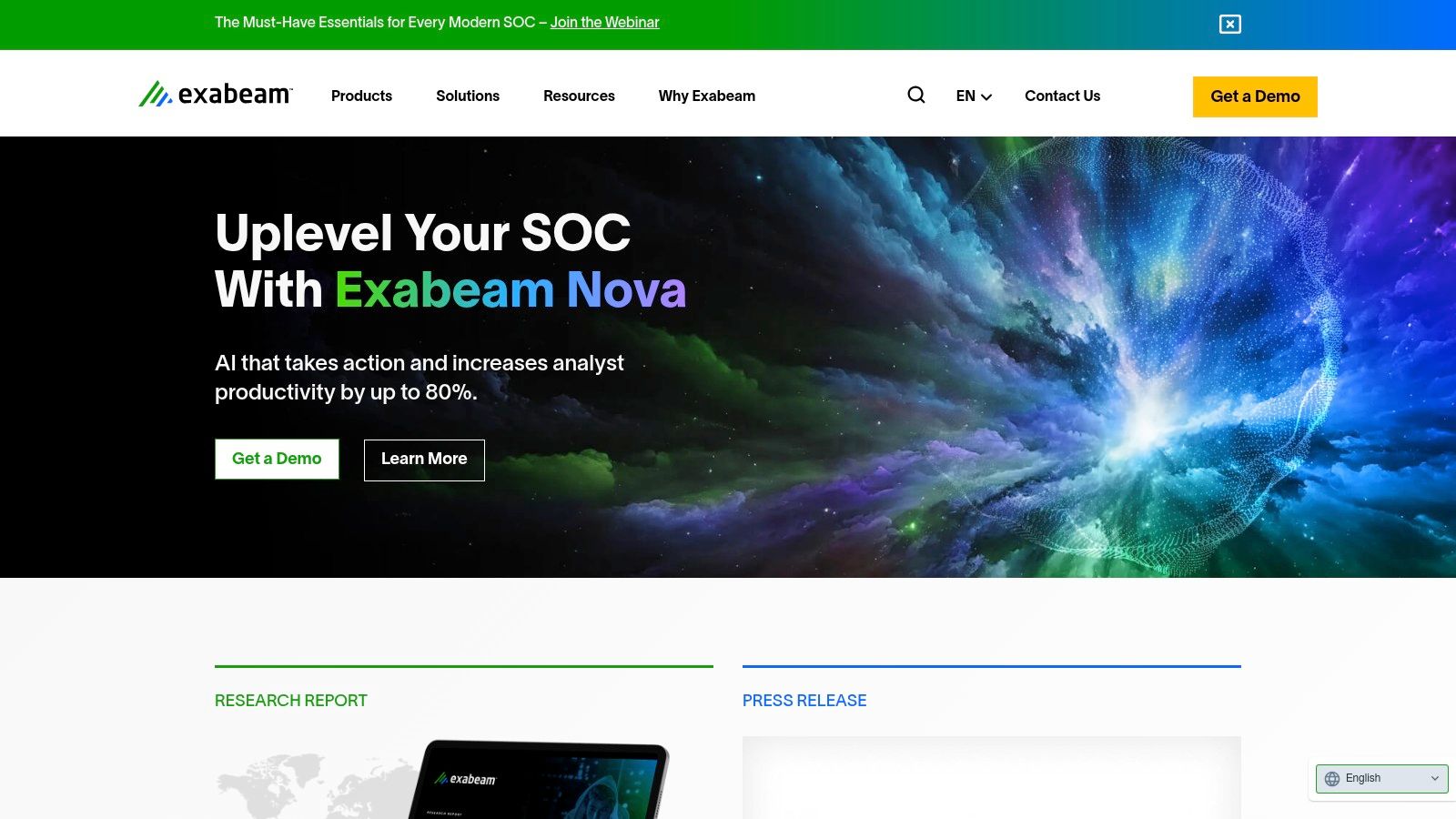
For a senior living facility, Exabeam can baseline the normal network activity of staff and medical devices. If a nurse’s credentials are used to access resident data at an unusual time or from an unfamiliar location, the platform flags this as a high-risk anomaly. Its automated response playbooks can then temporarily restrict account access and alert the IT team, significantly reducing the window for a potential data breach. This focus on behavioral context provides a critical layer of security for protecting sensitive personal health information.
Key Features and Considerations
- Behavioral Analytics: Creates a baseline of normal user and device behavior to accurately detect deviations that signal a potential threat.
- Automated Incident Response: Features pre-built playbooks that automate containment and investigation tasks, reducing manual effort and response times.
- Implementation: The initial setup can be complex and resource-intensive, often requiring specialized expertise to properly configure data sources and tune the analytics engine.
- Pricing: Exabeam is positioned as a premium solution, and its pricing reflects its advanced capabilities. It is best suited for organizations with mature security programs and dedicated budgets.
6. Cisco SecureX
Cisco SecureX is a cloud-native platform designed to unify visibility and streamline security operations by integrating an organization’s entire security portfolio. It acts as a cohesive layer that connects Cisco and third-party security products, allowing teams to automate workflows and respond to threats faster. This integrated approach makes it one of the more powerful network security monitoring tools for businesses already invested in the Cisco ecosystem, as it simplifies complexity and enhances the value of existing security investments.
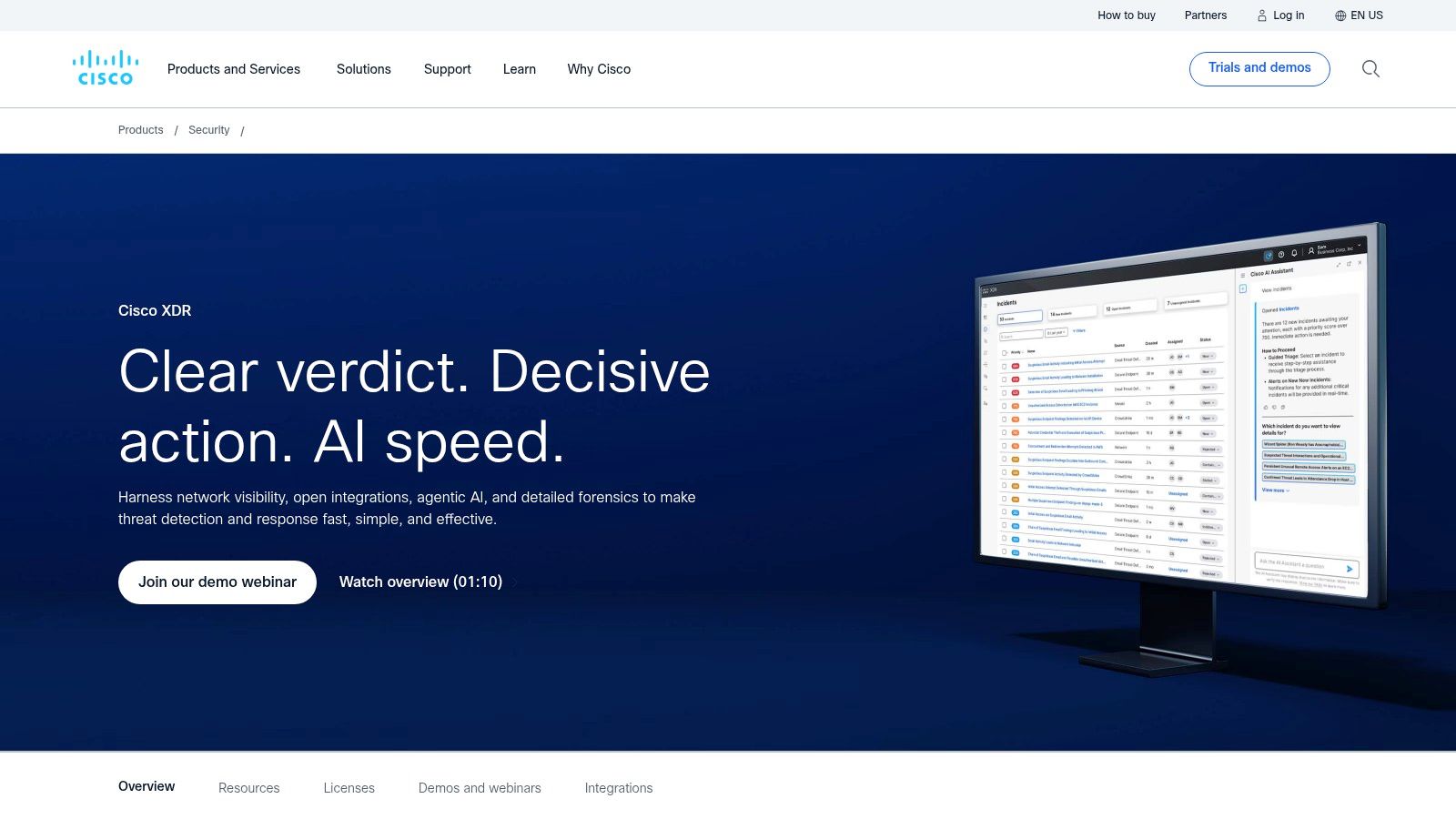
For a large commercial venue with diverse security solutions for endpoints, firewalls, and email, SecureX can consolidate alerts into a single dashboard. This allows IT staff to investigate an incident by seeing its entire lifecycle across different systems without switching between multiple consoles. Its automation capabilities can be used to block a malicious IP address across all integrated firewalls simultaneously once a threat is confirmed, significantly reducing response time and potential damage.
Key Features and Considerations
- Unified Visibility: Aggregates data from multiple security sources into a single, customizable interface, providing a comprehensive view of the threat landscape.
- Automated Threat Response: Features orchestration playbooks that automate routine security tasks and threat responses, freeing up security teams for more critical analysis.
- Implementation: While included with many Cisco Security products, full implementation requires integrating various APIs. This can be complex without dedicated IT expertise.
- Pricing: SecureX itself is generally included with eligible Cisco Security products, but the total cost of ownership is tied to the underlying Cisco solutions, which can be a significant investment for smaller organizations.
7. Microsoft Sentinel
Microsoft Sentinel emerges as a formidable cloud-native SIEM and Security Orchestration, Automation, and Response (SOAR) solution. For organizations heavily invested in the Microsoft ecosystem, it provides intelligent, scalable security analytics across the enterprise. By integrating seamlessly with Azure and Microsoft 365, it simplifies the process of collecting and correlating data from various sources, making it a highly effective choice among network security monitoring tools for businesses looking to centralize their security operations in the cloud.
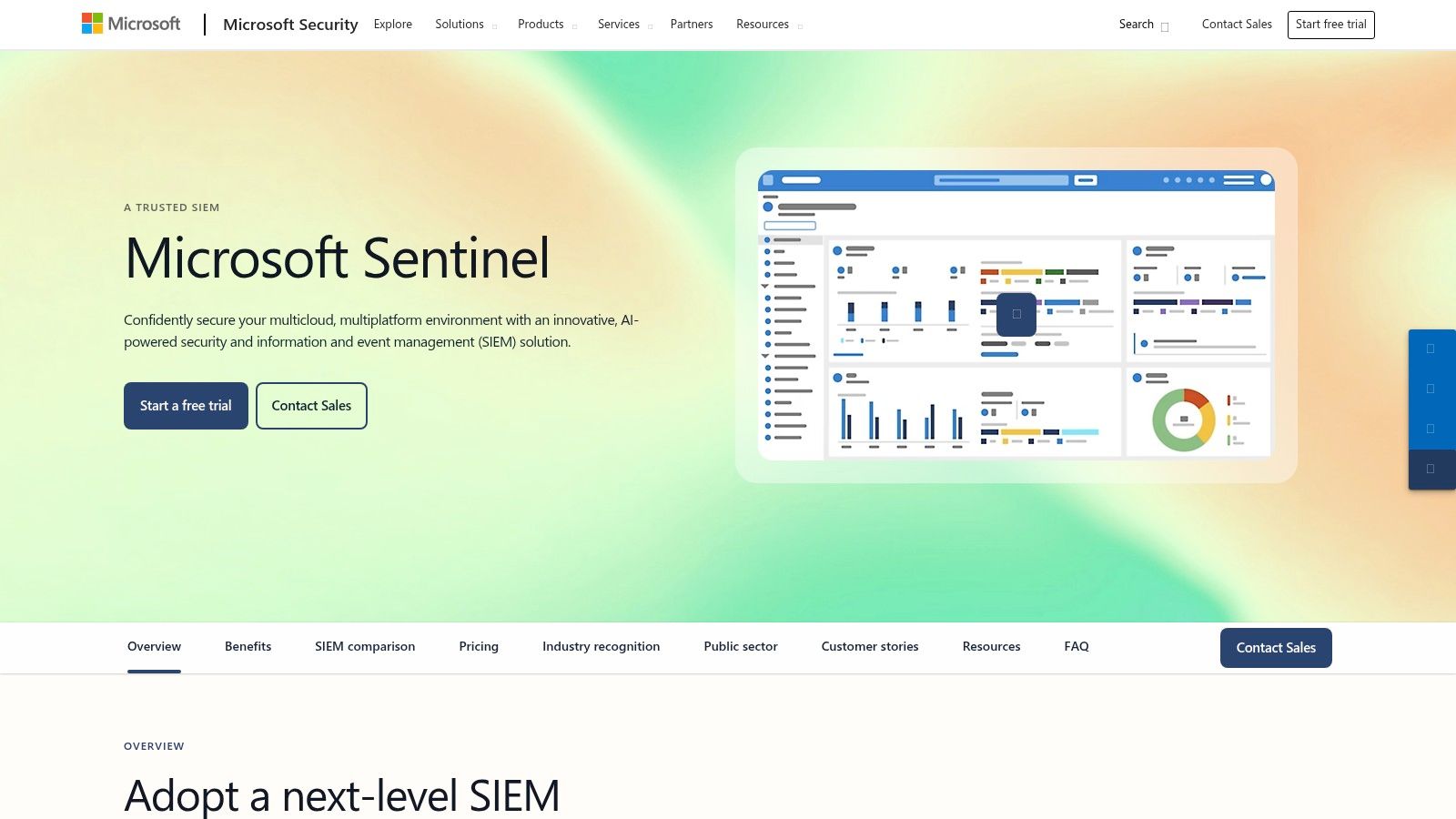
Imagine a large commercial office building using Microsoft 365 for communications and Azure for its tenant management applications. Sentinel can analyze login data, email traffic, and network activity to automatically detect and respond to a phishing attack targeting tenants, isolating affected accounts before the threat spreads. This automated response capability is a key advantage, reducing manual effort for IT teams. For organizations exploring such integrated security, understanding the benefits of a holistic approach is key, and you can learn more about the advantages of managed network security.
Key Features and Considerations
- Cloud-Native Integration: Offers deep, out-of-the-box integration with Azure services and Microsoft 365, providing immediate visibility without complex configuration.
- AI-Driven Analytics: Leverages artificial intelligence to hunt for threats, reduce alert fatigue by grouping related incidents, and accelerate investigation.
- Implementation: While user-friendly for those familiar with Azure, optimal configuration requires Azure expertise. Its effectiveness in non-Microsoft environments can be limited without specific connectors.
- Pricing: Sentinel’s pricing is tied to Azure Monitor Log Analytics data ingestion and retention, which can be cost-effective for Azure-centric businesses but may lead to variable costs.
8. Fortinet FortiGate
Fortinet FortiGate serves as a powerful next-generation firewall (NGFW) that integrates comprehensive security features, including SD-WAN, into a single platform. It excels at delivering high-performance threat protection by inspecting both clear-text and encrypted traffic without creating performance bottlenecks. For properties managing extensive public and private networks, such as a large resort or a multi-building apartment complex, FortiGate offers a unified solution. This makes it one of the most effective network security monitoring tools for organizations needing to secure diverse network endpoints while maintaining optimal performance.
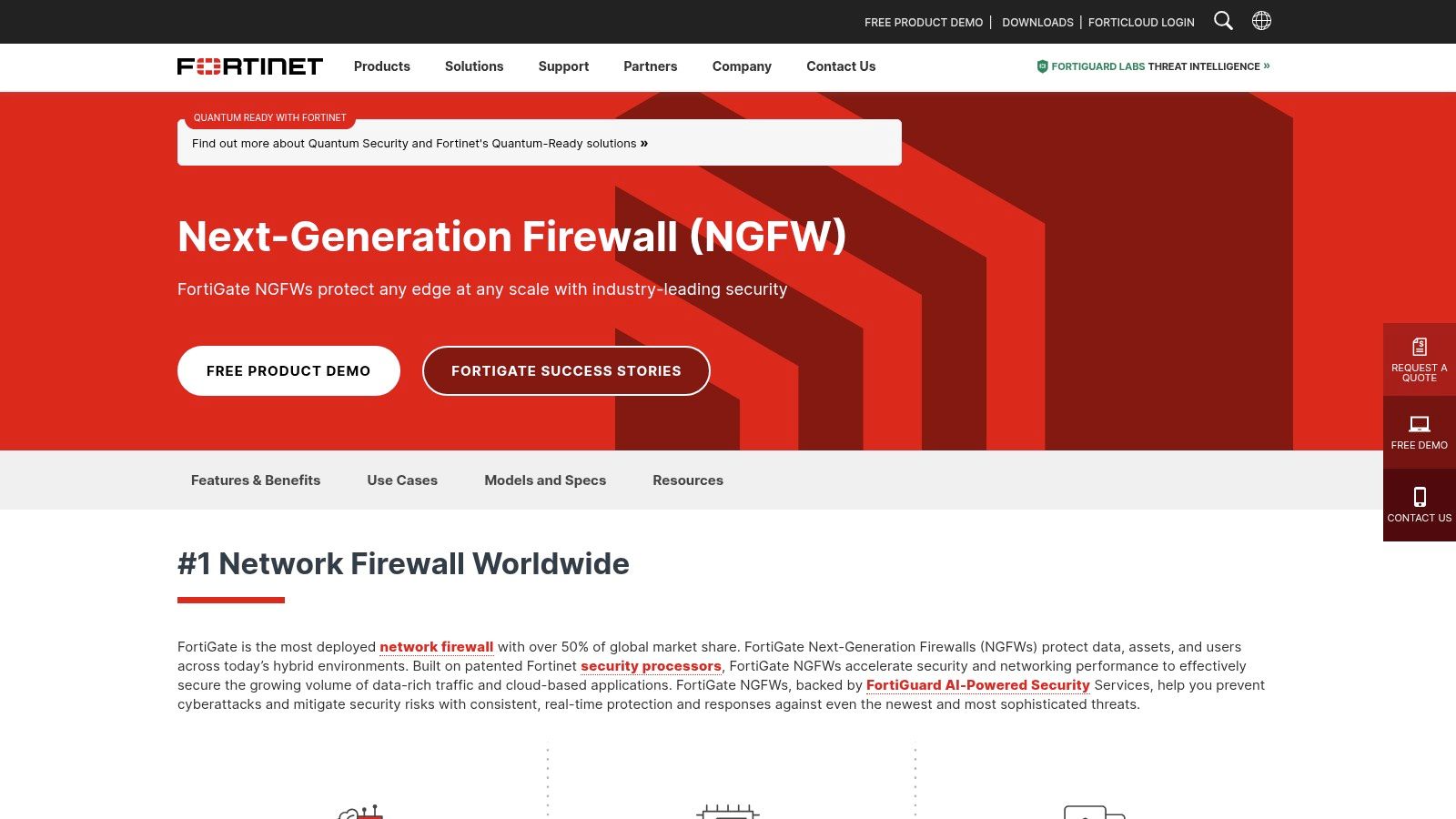
Imagine a senior living facility that needs to provide secure internet for residents, manage IoT devices for health monitoring, and protect its own administrative network. FortiGate can segment these networks, applying specific security policies to each. Its AI-driven FortiGuard services continuously update threat intelligence, protecting against emerging malware and intrusions. This centralized control simplifies complex network management, ensuring resident data and critical systems are protected without requiring multiple disparate security products.
Key Features and Considerations
- Integrated SD-WAN: Simplifies network architecture by combining networking and security functions, which is ideal for businesses with multiple locations or properties.
- AI-Driven Threat Protection: Leverages real-time threat intelligence from FortiGuard Labs to proactively block new and sophisticated attacks.
- Implementation: While the user interface is relatively friendly, advanced configuration for features like granular application control and VPN tunnels requires specialized knowledge.
- Pricing: The cost includes hardware and subscriptions for security services. This model can be more expensive upfront compared to software-only solutions, making it a better fit for mid-sized to large enterprises.
9. SolarWinds Security Event Manager
SolarWinds Security Event Manager (SEM) offers a robust SIEM solution designed for real-time threat detection and automated response. It distinguishes itself by combining comprehensive log management with an intuitive user interface, making it a powerful yet accessible choice among network security monitoring tools. SEM excels at collecting, correlating, and analyzing security logs from across your network to identify suspicious activities and enforce policy compliance.
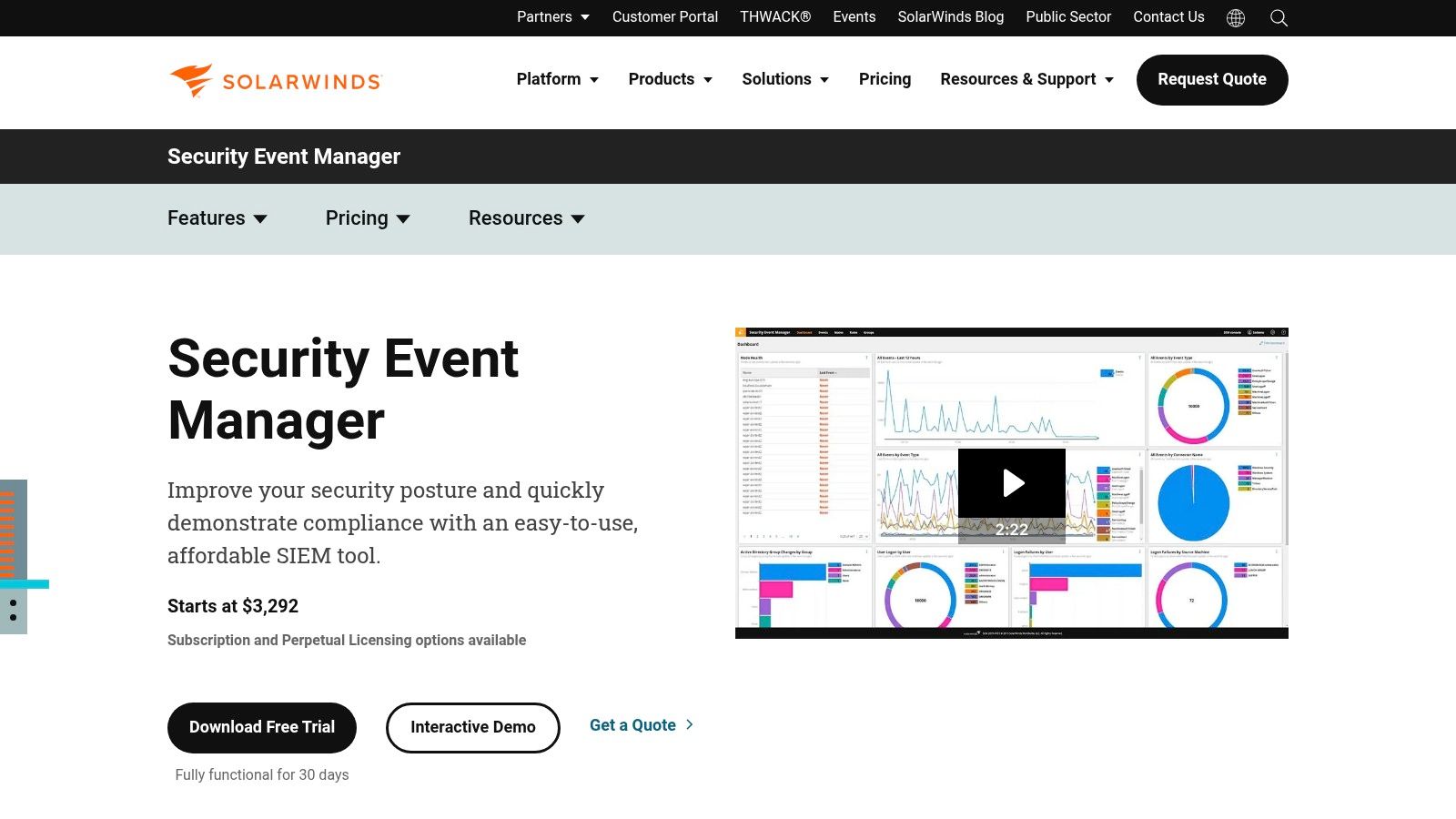
For a commercial venue or senior living facility, SEM can monitor user activity on both wired and wireless networks, automatically flagging unusual login times or access to sensitive systems. For example, it can detect and block a USB device that violates security policy or quarantine an account showing signs of compromise, preventing potential data theft. Its automated response capabilities are critical for resource-strapped IT teams, enabling them to neutralize threats instantly without manual intervention.
Key Features and Considerations
- Automated Threat Response: Features built-in active responses that can automatically block IPs, shut down machines, or disable user accounts when a threat is detected.
- Centralized Log Collection: Gathers logs from hundreds of sources, including firewalls, routers, servers, and applications, normalizing the data for easy analysis and reporting.
- Compliance Reporting: Includes pre-built templates for common regulations like HIPAA and PCI DSS, simplifying the auditing process for hospitality and healthcare-related properties.
- Implementation: While user-friendly, the initial deployment can be resource-intensive and requires careful planning to configure log sources correctly for optimal performance.
- Pricing: SolarWinds SEM is priced per node, which can become costly for smaller organizations but offers scalability for larger enterprises.
10. Nagios XI
Nagios XI offers a powerful and flexible framework for monitoring network infrastructure, servers, and applications, making it a staple among experienced IT professionals. Building upon the open-source Nagios Core engine, it provides a more user-friendly web interface and commercial support. As one of the most established network security monitoring tools, its strength lies in its incredible customizability, allowing administrators to monitor virtually any device or service with an IP address, from routers and switches to specialized IoT devices in a smart building.
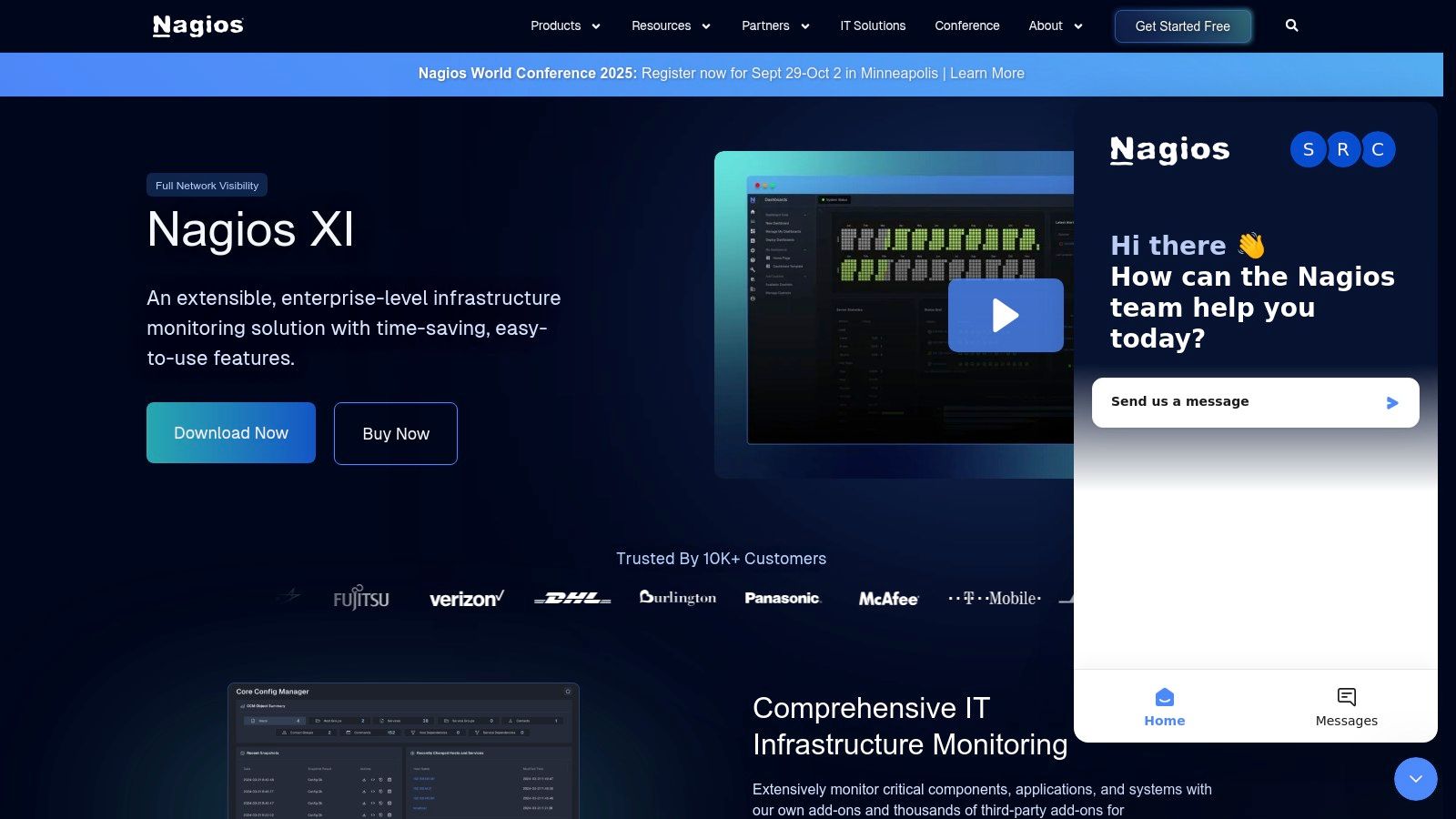
For a senior living facility, Nagios XI can monitor the uptime and responsiveness of critical systems like nurse call systems, IP-based security cameras, and environmental sensors. Its granular alerting system ensures that any failure, such as a disconnected Wi-Fi access point in a common area or a server hosting resident records becoming unresponsive, immediately notifies the right personnel. While it lacks the advanced, AI-driven threat detection of a SIEM, its proactive health and availability monitoring is fundamental to maintaining a secure and reliable network posture.
Key Features and Considerations
- Comprehensive Monitoring: Provides in-depth visibility into network protocols, system metrics, and application states, ensuring all components are performing as expected.
- Extensive Plugin Architecture: Taps into thousands of community-developed plugins, extending its monitoring capabilities to almost any technology or vendor-specific hardware.
- Implementation: The initial setup can be complex and time-consuming, especially for those new to Nagios. The tool’s power is unlocked through configuration files and plugins, which presents a steep learning curve.
- Pricing: Nagios XI is offered in Standard and Enterprise editions with pricing based on the number of monitored nodes. This makes it more accessible for smaller organizations than data-ingestion models, but the cost can escalate for large, complex environments.
11. Zeek (formerly Bro)
Zeek, formerly known as Bro, is a powerful open-source network analysis framework that operates differently from traditional signature-based Intrusion Detection Systems (IDS). Instead of just looking for known malicious patterns, Zeek observes all traffic and generates high-fidelity, comprehensive logs describing network activity. This deep protocol analysis makes it one of the most insightful network security monitoring tools for understanding exactly what is happening on your network, providing a rich data source for forensic investigations.
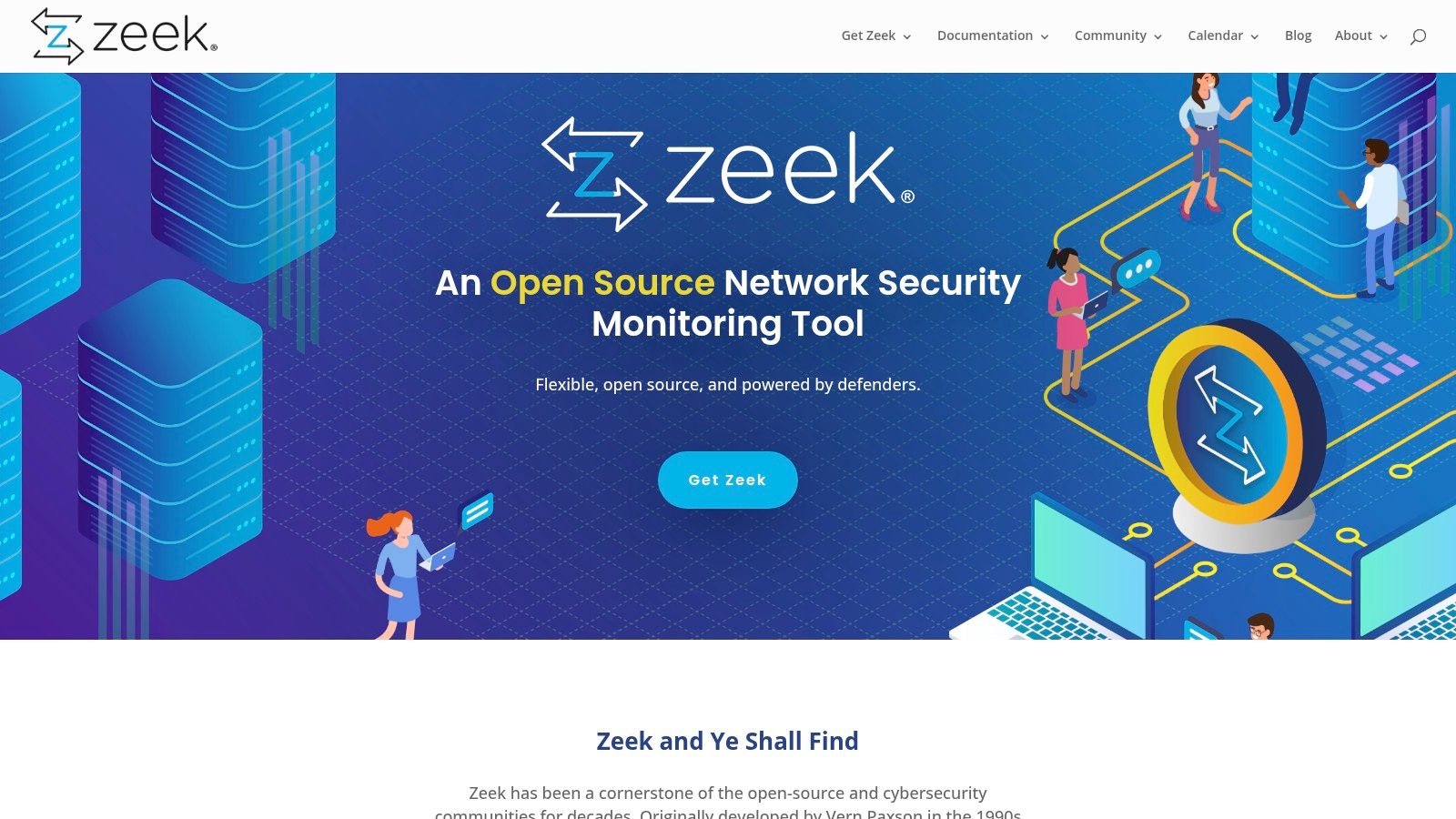
For a senior living facility, Zeek can monitor traffic from resident IoT devices and medical equipment, creating detailed logs of connections to external servers. This helps IT staff identify unauthorized communications or data exfiltration that could compromise sensitive health information. Its power lies in its adaptability; you can learn more about its place among essential tools in the network security toolkit to understand its unique role. While it requires expertise, its value in threat hunting and incident response is unparalleled for technically proficient teams.
Key Features and Considerations
- In-Depth Protocol Analysis: Generates detailed logs for numerous protocols (HTTP, DNS, SSL/TLS, etc.), providing granular visibility into network communications.
- Customizable Scripting: Uses its own scripting language, allowing security teams to create highly specific, policy-driven monitoring rules tailored to their environment.
- Implementation: As an open-source framework, it has no licensing cost but demands significant technical expertise to deploy, configure, and maintain effectively. The learning curve is steep.
- Functionality: It is not an out-of-the-box solution. Zeek provides the data and framework, but it must be integrated with other tools like a SIEM for visualization and alerting.
12. Security Onion
Security Onion is a free, open-source Linux distribution designed specifically for threat hunting, enterprise security monitoring, and log management. It bundles a suite of powerful open-source tools like Suricata, Snort, Zeek, and the Elastic Stack into a single, cohesive platform. This makes it an incredibly versatile choice among network security monitoring tools, particularly for organizations that require deep visibility and forensic capabilities without the high licensing costs of commercial SIEMs.
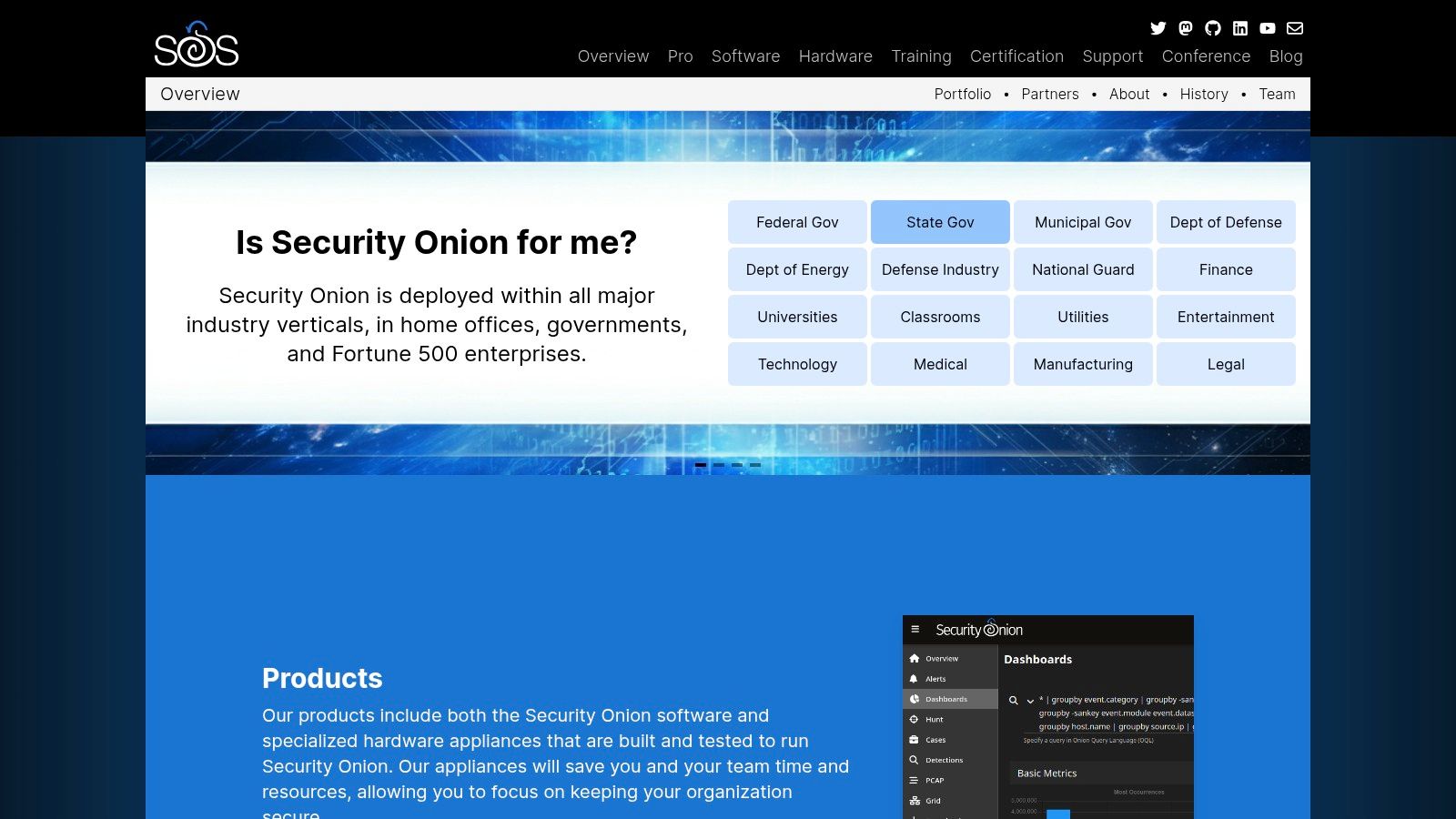
For a multi-site commercial property manager, Security Onion can be deployed to monitor network traffic for malicious patterns, such as repeated connection attempts to a known command-and-control server. Its integrated tools provide full packet capture, allowing an IT team to reconstruct security incidents with granular detail. This level of analysis is crucial for understanding the scope of a breach and preventing future occurrences. The active community provides extensive support, which is invaluable for teams navigating its complexities.
Key Features and Considerations
- Integrated Toolset: Combines network intrusion detection (Suricata/Snort), host intrusion detection (Wazuh), and log analysis (Elastic Stack) in one platform.
- Cost-Effective: As an open-source solution, it eliminates software licensing fees, making it an attractive option for budget-conscious organizations.
- Implementation: The setup is complex and resource-intensive, requiring dedicated hardware and significant technical expertise in Linux and networking. The learning curve is steep.
- Support Model: While community support is strong, official enterprise-grade support and hardware appliances are available through Security Onion Solutions, LLC for a fee.
Network Security Monitoring Tools Comparison
| Product | Core Features & Capabilities | User Experience ★ | Value Proposition 💰 | Target Audience 👥 | Unique Selling Points ✨ |
|---|---|---|---|---|---|
| Splunk Enterprise Security | Real-time analytics, automated incident response | ★★★★☆ High scalability, customization | 💰 Premium pricing, enterprise-grade | Large enterprises & security teams | 🏆 Advanced ML detection, strong integrations |
| IBM QRadar | Threat detection, compliance, behavioral analysis | ★★★★☆ User-friendly, reduces false positives | 💰 Premium pricing, scalable | Large enterprises & regulated industries | ✨ Strong IBM ecosystem integration |
| Palo Alto Cortex XDR | AI-driven behavioral analytics, multi-layer visibility | ★★★★☆ Unified experience, high accuracy | 💰 Higher cost, top-tier security | Large enterprises | ✨ AI-driven, multi-domain threat response |
| Darktrace | Self-learning AI, automated response | ★★★★☆ Minimal config, intuitive UI | 💰 Higher cost, AI-driven defense | Enterprises seeking unknown threat detection | 🏆 Autonomous AI & Antigena response |
| Exabeam | SIEM + UEBA + SOAR, automation | ★★★★☆ Reduces manual work, customizable | 💰 Premium pricing, scalable | Large enterprises | ✨ Insider threat detection, workflow automation |
| Cisco SecureX | Unified management, automation, integrations | ★★★★☆ User-friendly, efficient automation | 💰 Higher cost for smaller orgs | Cisco-centric enterprises | ✨ Centralized multi-tool orchestration |
| Microsoft Sentinel | Cloud-native SIEM/SOAR, AI analytics, MS integration | ★★★★☆ Cost-effective with Azure, easy UI | 💰 Flexible pricing linked to Azure usage | Azure-based enterprises | ✨ Deep Microsoft eco integration |
| Fortinet FortiGate | NGFW + SD-WAN, AI threat protection | ★★★★☆ User-friendly, centralized mgmt | 💰 Higher cost for small orgs | Enterprises needing integrated firewall | ✨ SD-WAN + AI security combo |
| SolarWinds Security Event Manager | Automated threat detection & response, compliance | ★★★☆☆ User-friendly, effective dashboards | 💰 Higher cost for small orgs | Mid to large enterprises | ✨ Compliance focused, centralized logging |
| Nagios XI | Network/server/app monitoring, customizable alerts | ★★★☆☆ Highly flexible, plugin support | 💰 Higher cost for small orgs | Complex network environments | ✨ Extensive plugins, capacity planning |
| Zeek (formerly Bro) | Network protocol analysis, scripting, forensics | ★★★☆☆ Highly customizable & forensic | 💰 Free, but expertise heavy | Network analysts & security experts | ✨ Custom scripting, deep network insights |
| Security Onion | IDS, log management, multi-tool integration | ★★★☆☆ Cost-effective, feature-rich | 💰 Free open-source | Security teams & open-source enthusiasts | 🏆 Comprehensive open-source monitoring suite |
Choosing Your Path: Integrating Tools into a Cohesive Security Strategy
Navigating the landscape of network security monitoring tools can feel overwhelming. We’ve explored a diverse range of solutions, from comprehensive SIEM platforms like Splunk Enterprise Security and IBM QRadar to AI-driven innovators like Darktrace and the powerful, open-source frameworks of Security Onion and Zeek. The key takeaway is clear: there is no universal “best” tool. The optimal choice is fundamentally tied to your organization’s unique operational realities, technical expertise, and risk tolerance.
A small boutique hotel chain has vastly different security requirements and resources than a large multi-family residential complex or a high-traffic commercial retail venue. While a tool like Microsoft Sentinel might offer seamless integration for an organization already deep in the Azure ecosystem, a business needing granular, hands-on control might find more value in a customizable solution like Nagios XI. The most critical step is to move beyond feature lists and honestly assess which platform aligns with your specific needs.
Key Considerations for Your Selection Process
Making the right decision involves more than just comparing pricing and features. The true measure of a tool’s effectiveness lies in its implementation and ongoing management. Before committing to a solution, your team must carefully consider several practical factors:
- In-House Expertise: Do you have a dedicated IT team with the skills to deploy, configure, and actively manage a sophisticated platform like Palo Alto Networks Cortex XDR or Exabeam? Open-source tools, while free, demand significant technical proficiency for tuning and maintenance.
- Integration and Interoperability: How well will the new tool integrate with your existing infrastructure? Consider your current firewalls (like FortiGate), cloud services, and endpoint protection. A platform like Cisco SecureX excels at unifying disparate security products into a single console.
- Scalability and Future Growth: Your chosen tool must be able to grow with your business. For property management companies expanding into new multi-family or senior living facilities, a scalable solution is not just a benefit; it’s a necessity.
- Alert Fatigue Management: More data is not always better. A critical, yet often overlooked, factor is the ability to tune the system to minimize false positives and prevent your team from being overwhelmed by a constant flood of low-priority alerts.
Beyond the Tool: Building a Resilient Security Posture
Ultimately, purchasing a license for one of these powerful network security monitoring tools is just the beginning. The real work involves transforming raw data into actionable intelligence. This requires continuous monitoring, expert analysis, and a rapid, coordinated response when a genuine threat is identified. For many businesses in the hospitality, commercial, and residential sectors, building and retaining an in-house team with this specialized skill set is a significant operational and financial challenge.
The true value is not in the tool itself, but in the security outcomes it enables. A well-managed security monitoring strategy provides the peace of mind that comes from knowing your digital assets, customer data, and business reputation are protected around the clock. This allows you to focus on what you do best: serving your guests, residents, and customers, confident that your network is secure and resilient against emerging threats.
Are you ready to implement enterprise-grade network security without the burden of managing it in-house? Clouddle Inc. provides a comprehensive Network-as-a-Service (NaaS) solution, leveraging best-in-class tools and expert management to secure your properties. Let us handle the complexity of network security monitoring so you can focus on growing your business. Visit Clouddle Inc. to learn how we can build a customized security strategy for you.


